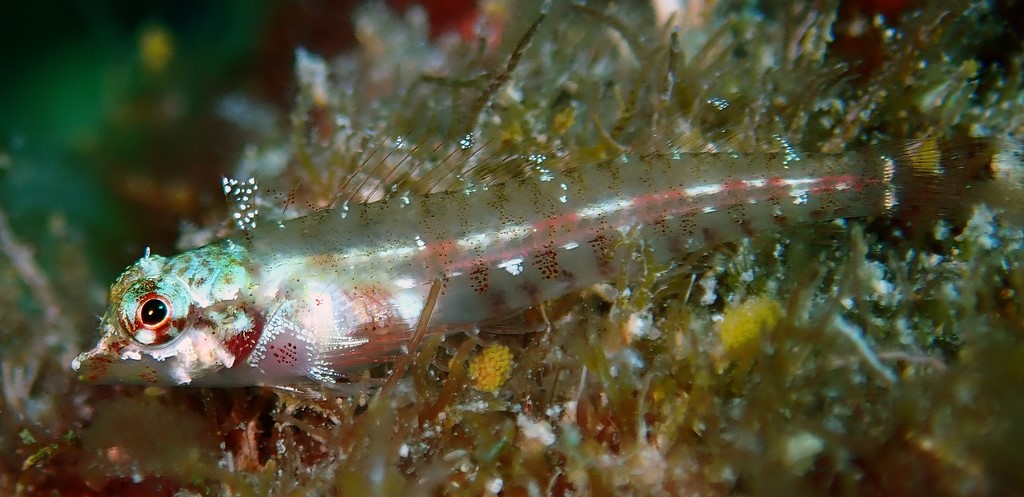ENNEAPTERYGIUS PALLIDOSERIALIS - (FRICKE, 1997)
Picture courtesy of: Alain Daoulas
Pale white-spotted triplefin, Pale-spotted triplefin, Atama tenten, 頭テンテン, 淡白斑雙線鳚, 蒼白雙線鳚,
Description
First Dorsal spines (total): 3; Second dorsal soft rays (total): 11-13 (usually: 12); Third dorsal soft rays (total): 8-10 (usually: 9); Anal spines: 1; Anal soft rays: 16-19 (usually: 17); Lateral line: 14-20 (usually: 17) tubular pored scales, reaching to below last third of second dorsal fin base, 14-21 (usually: 20) notched scales. Mandibular pore pattern: 3-4 + 1-2 + 3-4 (usually: 4 + 2 + 4). Supraorbital tentacle relatively long and simple. First dorsal fin lower than second dorsal fin in both sexes. Posttemporal lateral line branch slightly U-shapped. Head lateral line system moderately complex. Max. length: 3.0 cm SL. Depth range: 0 - 50 m.
Color
Males: head yellowish, densely covered with melanophores, two vertical suborbital dark streaks and a dark brown blotch on the lower half of the pectoral fin base. Body dark brown in males, back with a series of 4-10 whitihs spots, lower sides of the body with a series of 3-8 vertical whitish streaks or spots. First and second dorsal fins densely covered with melanophores. Third dorsal, caudal and pectoral fins dark gray. Anal fin blackish. Pectoral fin whitish.
Females: head and body yellowish, head with a short preorbital brown streak and a few suborbital brown spots. Anterior sides of body with two double dark brown bars surronding whitish spots. Lower sides of body behind the bars may bear about 6 faint vertical bars forming whitish spots. First dorsal fin translucent, whit a few melanophores scattered around the spines. Second dorsal fin translucent, bassly dark gray. Third dorsal, caudal, pectoral and pelvic fins translucent or whitish. Anal fin may bear about 9 oblique brown bands.
Etymology
Enneapterygius: from Greek, ennea = numeral nine + from Greek, pterygion = little fin. Referring to nine fins (3 dorsal, 2 pectoral, 2 ventral or pelvic, 1 anal, 1 caudal).
pallidoserialis: from Latin, pallidus = pale + from Latin, serialis = in a series (here a series of spots). The name refers to the pale color pattern and its similarity to Enneapterygius triserialis.
Original description: Enneapterygius pallidoserialis Fricke, 1997 - Type locality: Putic Island, northwestern side (Cuyo Island), Palawan Province, Philippines, 10°55'05"N, 121°02'03"E, depth 0 - 4.5 meters.
Distribution
Western Pacific: Malaysia, Philippines, Taiwan, Japan, New-Caledonia, Vanuatu and Chuuk.
Biology
Adults are found in shallow waters and outside barrier reefs. Eggs are hemispherical and covered with numerous sticky threads that anchor them in the algae on the nesting sites. Larvae are planktonic which occur primarily in shallow, nearshore waters. Sexes differ in the darker coloration of the male, especially the body and vertical fins dark brown or gray.
Similar species
Enneapterygius paucifasciatus (Fricke, 1994) - Reported from New Caledonia.
Enneapterygius triserialis (Fricke, 1994) - Reported from New Caledonia.
Last update: 26, June 2022
